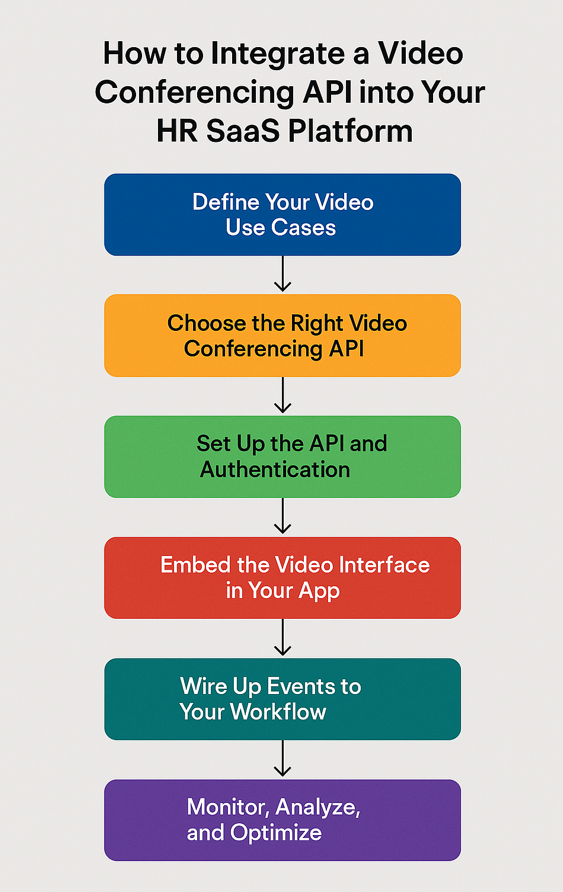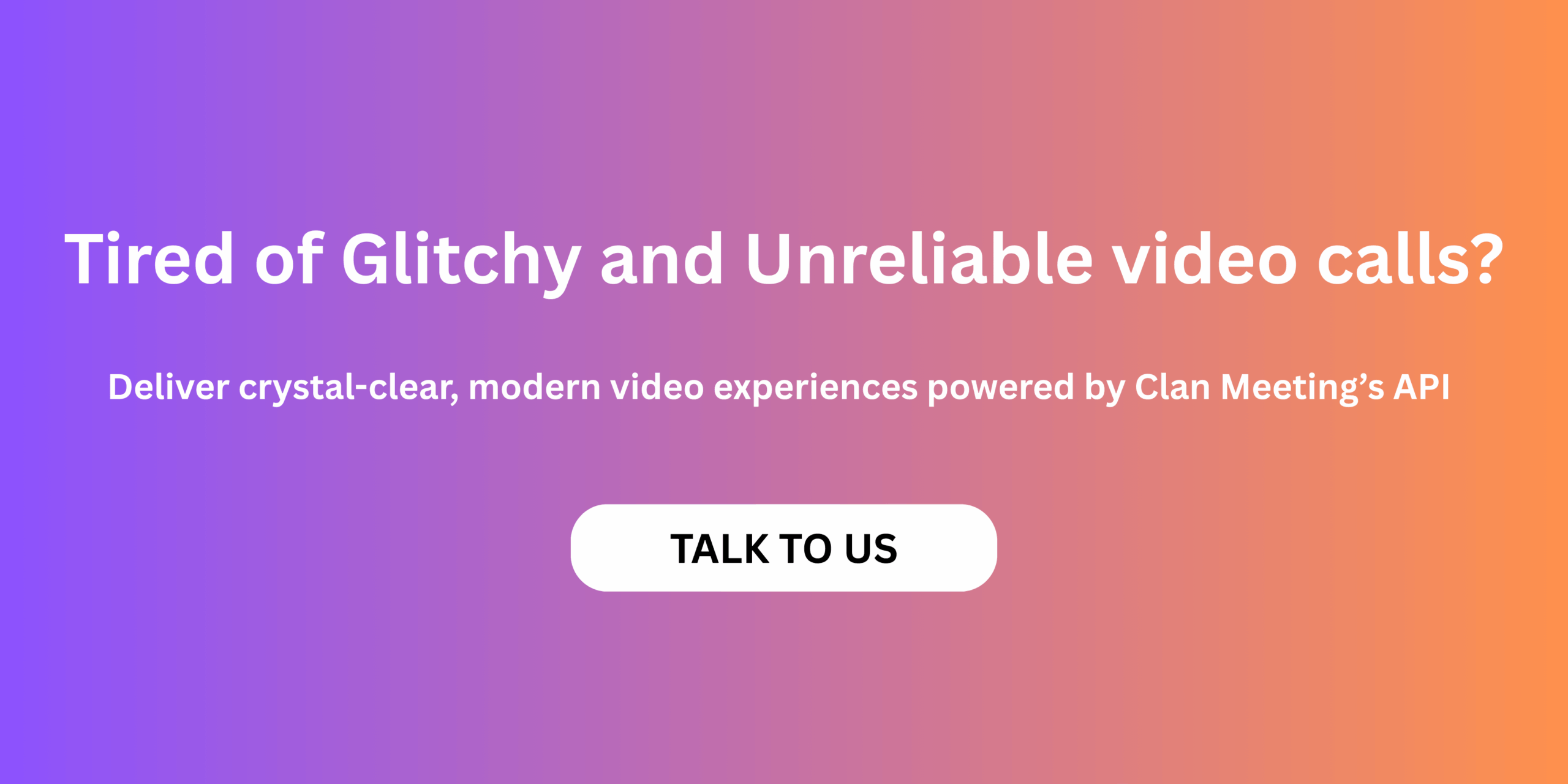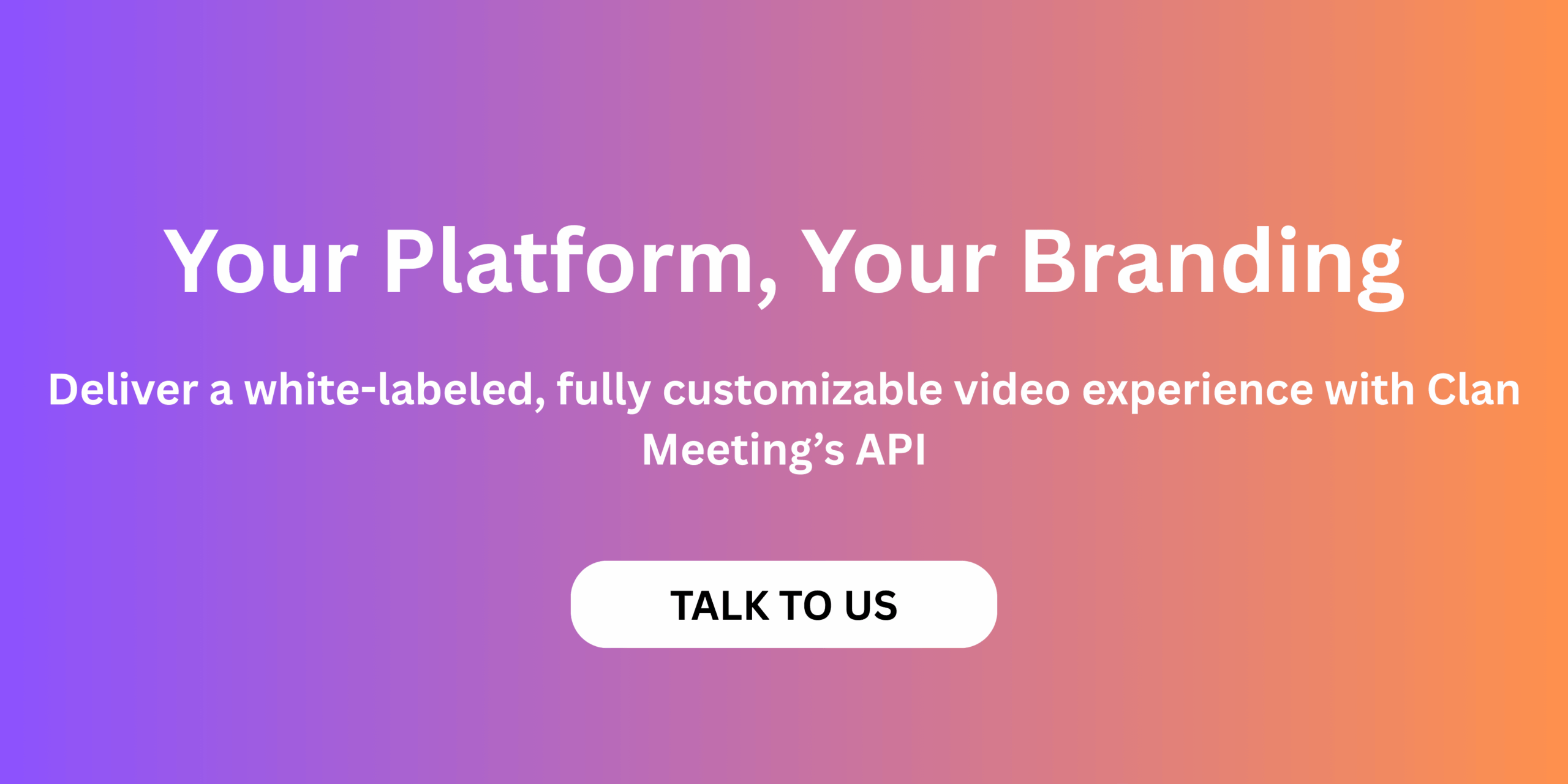Video is no longer just a feature - it is the core part of the infrastructure layer of any HRTech SaaS platform that uses that uses native video conferencing to deliver seamless, branded, and workflow driven user experiences.
The challenge? Doing it without bloating your roadmap or burning engineering cycles.
If you are looking to integrate a video chat API tailored for HRTech you already know how often video touchpoints emerge - first-round interviews, onboarding welcome calls, internal check-ins - each one is a moment where switching tools breaks focus.
That context-switch is exactly what embedded video solves.
But integrating real-time video is not just a developer task - it is a product decision. It has to fit your user flow, your brand, and your infrastructure.
If you are planning to integrate a video conferencing API into your HR platform, the steps ahead will help you do it efficiently and without added complexity.
Why Native Video Conferencing Matters in HRTech
Think about the last time a recruiter had to copy-paste a Zoom link into an ATS note. Or when a candidate had to download yet another app just to join a 15-minute intro call.
That friction adds up and it reflects on your platform.
Embedded video solves this by turning video calls into seamless, branded, in-flow experiences. Interview invites are buttons and not links. Onboarding feels more like a part of the app and not another interruption. And the data stays in your system, not some third-party platform giving you a huge peace of mind.
Done right, and embedded video solution helps you I multiple ways -
- Full brand control over the video experience
- Compliance confidence (GDPR, CCPA, and internal audit logs)
- Faster handoffs between interviewers, coordinators, and hiring managers
- Better data fidelity (no more missed notes or mismatched timestamps)
Now that we have seen why having a native video conferencing matters, let's look at the steps that you can follow to set it up.

Step 1: Define Your Video Use Cases
Start by identifying the video touchpoints that matter most to your users.
Maybe your customers want to conduct first-round interviews without switching tools. Or perhaps your platform supports onboarding, and adding live video helps HR managers deliver a more personal welcome. Internal team syncs, performance reviews, or live training sessions are also common high-impact areas.
Your use cases will guide the technical requirements. For example -
- Do you need 1:1 or multi-party video?
- Will calls be recorded?
- Is screen sharing important for certain roles?
- Do you need role-based permissions or waiting rooms?
Each of these questions maps to feature decisions like multi-party rooms, screen sharing, mobile optimization, or recording. Clarifying this first will make the rest of the integration far more efficient.
Step 2: Choose the Right Video API to Integrate a Video Conferencing Experience Seamlessly
There are plenty of video APIs but most are either over-engineered or too generic.
In HRTech, your users care about reliability, performance across regions, and privacy. You care about ease of integration, cost control, and UI flexibility.
Here is what to look for -
- A usage-based pricing model that matches your hiring volume
- Global, low-latency performance so interviews work anywhere
- UI theming and prebuilt components to get up and running fast
- Web and mobile SDKs to cover every touchpoint
- End-to-end encryption, audit logs, and compliance baked in
- Friendly documentation and support that saves developer time
Platforms like Clan Meeting are designed with these HRTech needs in mind especially when it comes to fast setup and flexible UI.
Step 3: Set Up the API and Authentication
Once you choose your provider, the setup is usually fast. With Clan Meeting, for example, you would -
- Sign up and grab your API keys
- Install the SDK using NPM or script tags
npm install @clanmeeting/video-sdk
- Set up secure authentication - usually via JWT or OAuth. For instance -
const token = await generateMeetingToken(userId, role);
- Create the meeting session -
const room = await ClanMeeting.createRoom({
meetingName: 'Initial Interview – Sales Engineer',
metadata: {
jobId: '4532',
candidateId: '8821'
}
});
This structure makes it easy to link video sessions to specific jobs, candidates, or interviewers inside your app.
Step 4: Embed the Video Interface in Your App
Once the room is ready, you embed the video interface in your frontend. You can go live fast with prebuilt components or build your own interface from scratch using the headless SDK.
To keep things simple -
<ClanMeetingVideoRoom
roomId={room.id}
token={token}
theme="light"
onEnd={handleSessionEnd}
/>
This approach gives you full control of the experience - brand colors, button layout, waiting room logic—without reinventing the wheel.
Step 5: Wire Up Events to Your Workflow
The power of embedding video into your HR platform is not just about video - it is about automation.
You can connect session lifecycle events directly to your app:
- When a session starts, log the event in the candidate’s activity timeline.
- When it ends, trigger a feedback form or update the job stage.
Example:
onEnd={() => updateCandidateStage(candidateId, 'interviewed')}
This is where embedded video becomes a competitive advantage.

Step 6: Monitor, Analyze, and Optimize
After launch, make sure the video experience is doing its job -
- Are interviews dropping mid-call?
- Are users struggling to join sessions?
- How long are average calls? Are some features underused?
Track engagement, session stability, and UX feedback. Optimize bandwidth handling, error recovery, and entry points based on what you learn.
Clan Meeting offers real-time insights and event hooks that let you track these metrics and respond quickly.
Final Thoughts
Video workflows have become core to the HRTech experience. With a thoughtful integration strategy and the right API, you can build embedded video that feels like a native part of your product.
Whether you are enabling remote interviews, onboarding sessions, or internal syncs, the goal is simple - make it seamless for users and invisible in terms of engineering overhead.
Clan Meeting helps HRTech platforms launch fast, customize freely, and scale globally with video that just works.
Want to see it in action? Book a demo and explore how Clan Meeting powers real-time video inside real HR workflows.
Frequently Asked Questions
1. What is the best way to integrate a video conferencing API into an HRTech platform?
The most effective approach is to use a developer-friendly video API that supports real-time communication, prebuilt UI components, and flexible SDKs. The integration should be scoped around user workflows like interviews, onboarding, and internal meetings. Clan Meeting, for example, allows you to embed video in as few as 10 lines of code using a secure token-based setup.
2. How does embedded video improve the user experience in HR software?
Embedded video reduces tool-switching and streamlines the hiring or onboarding flow. Instead of relying on third-party links (like Zoom or Google Meet), video is rendered directly inside the application—making it feel native, branded, and tightly integrated with scheduling, feedback, and performance tracking.
3. What features should HRTech teams look for in a video conferencing API?
Key features include: HD audio/video, low-latency performance, screen sharing, call recording, role-based access, usage-based pricing, and support for compliance (GDPR/CCPA). Prebuilt components and mobile-ready SDKs also accelerate time-to-integration with minimal engineering overhead.
4. Can I customize the UI when using a video conferencing SDK?
Yes. Most advanced APIs like Clan Meeting offer both prebuilt and headless options. Prebuilt components allow for quick setup, while headless SDKs give teams full control over UI layout, branding, and in-call logic. This is essential for maintaining a consistent look and feel across the HR product.
5. Is it secure to embed video conferencing inside my HR application?
Yes, provided you use an API that offers token-based authentication, end-to-end encryption, session lifecycle controls, and logging. Look for platforms that are audit-friendly and support enterprise-grade compliance frameworks like SOC 2 and ISO 27001.
6. How do I measure the success of an embedded video feature in HR software?
Success metrics include call completion rates, time-to-connect, user feedback, interview throughput, and feature usage (e.g., screen sharing, recording). APIs like Clan Meeting provide real-time session analytics and event hooks to feed these insights directly into your HR platform’s backend.


